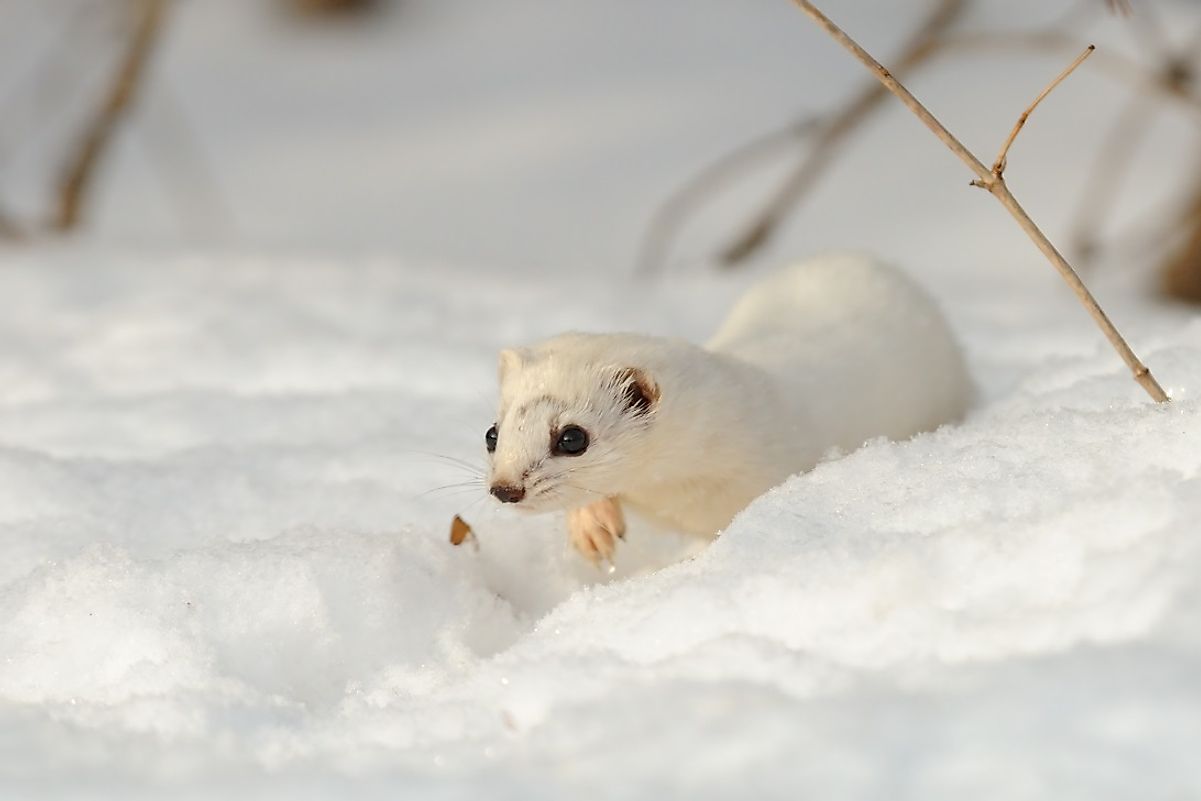Least Weasel Facts: Animals of North America

5. Physical Description
The Least Weasel is a mouse-sized weasel with a long slender body, short brown or white legs, and a tiny, streamlined head. It has short round ears, beady eyes, and a snout ending in whiskers. The Least Weasel's fur can be all white, or brown with a white streak stretching from its chin to its rump, while the tail is brown. Fur color changes can occur, often going from brown to white during winter, according to the Missouri Department of Conservation. The length of the males, including their tails, is up to 10 inches, and they weigh from 2.1 to 3.2 ounces, according to the Illinois Department of Natural Resources. Females are up to 9 inches in length, and weigh 1.2 to 2.5 ounces. The Least Weasel's paws have 5 clawed toes suitable to its carnivorous, predatory lifestyle.
4. Diet
As a small carnivore, the Least Weasel's main food sources are small rodents, such as mice, bank voles, and field voles. In a day, a Least Weasel can eat 1 to 1½ mice, totaling more than half of its own body weight. Still, the Least Weasel is an opportunistic predator that will also eat small fish, birds, insects, lizards, and birds' eggs. When the Least Weasel encounters its prey, it swiftly grabs it by the back of the head, and bites through its skull in quick succession. After about 30 seconds, the prey dies. After eating to its fill, Least Weasels store excess food in their burrow, to ensure that they have food for the future.
3. Habitat and Range
North American ranges like Alaska, Canada, and the northern United States, as well as much of Eurasia, are where the least weasel population are naturally found, with other population being introduced elsewhere, including parts of the Southern Hemisphere. In these ranges, the Least Weasel lives in meadows, grasslands, marshy areas, pastures, stubble field habitats, and mouse-infested barns. It inhabits burrows dug by moles and gophers, or hollow logs where the former cannot be found. On the International Union for Conservation of Nature’s (IUCN) 2008 Red List, the Least Weasel was classified as a species of "least concern" among threatened species. According to the IUCN, its population is stable, with its primary threats today being poisoning with rodenticides and change in agriculture practices within their home ranges.
2. Behavior
The Least Weasel, leads a solitary lifestyle except for when breeding. Though the Least Weasel is sometimes visible in the daytime, it’s most active at night. Both male and female Least Weasels defend their territories from others of the same sex, according to the Minnesota Department of Natural Resources. A single Least Weasel's territory can span up to 24.3 hectares, which they establish by giving off pungent odors from their anal glands. When threatened the Least Weaselit produces a loud, harsh chirp or screech, and assumes a "weasel war dance". This dance is characterized by leaps, twists, barks, and arching of the back. When it’s with a mate or summoning young ones, it Least Weasels may produce a low trill. The Least Weasel is the world's smallest carnivore, and is preyed upon by such other, larger predators as snakes, hawks, owls, foxes, coyotes, and house cats.
1. Reproduction
Sexual maturity begins from 3 to 4 months for the female Least Weasel when food is plentiful. Females sexually mature more rapidly, while males achieve maturity at around 8 or 9 months, according to Animal Diversity. Breeding may occur all year round, though incidences of mating are less frequent during the winter. Both sexes of Least Weasels will mate with multiple partners. Males and females defend their territory when mating, but afterwards the male will leave to look for other females "in heat". The Least Weasel's gestation period lasts about 35 days, after which the female gives birth to on average to 4 to 5 kits per litter.According to Animal Diversity, the Least Weasel's lifespan is 1 to 2 years in the wild, significantly shorter than many other carnivores.











